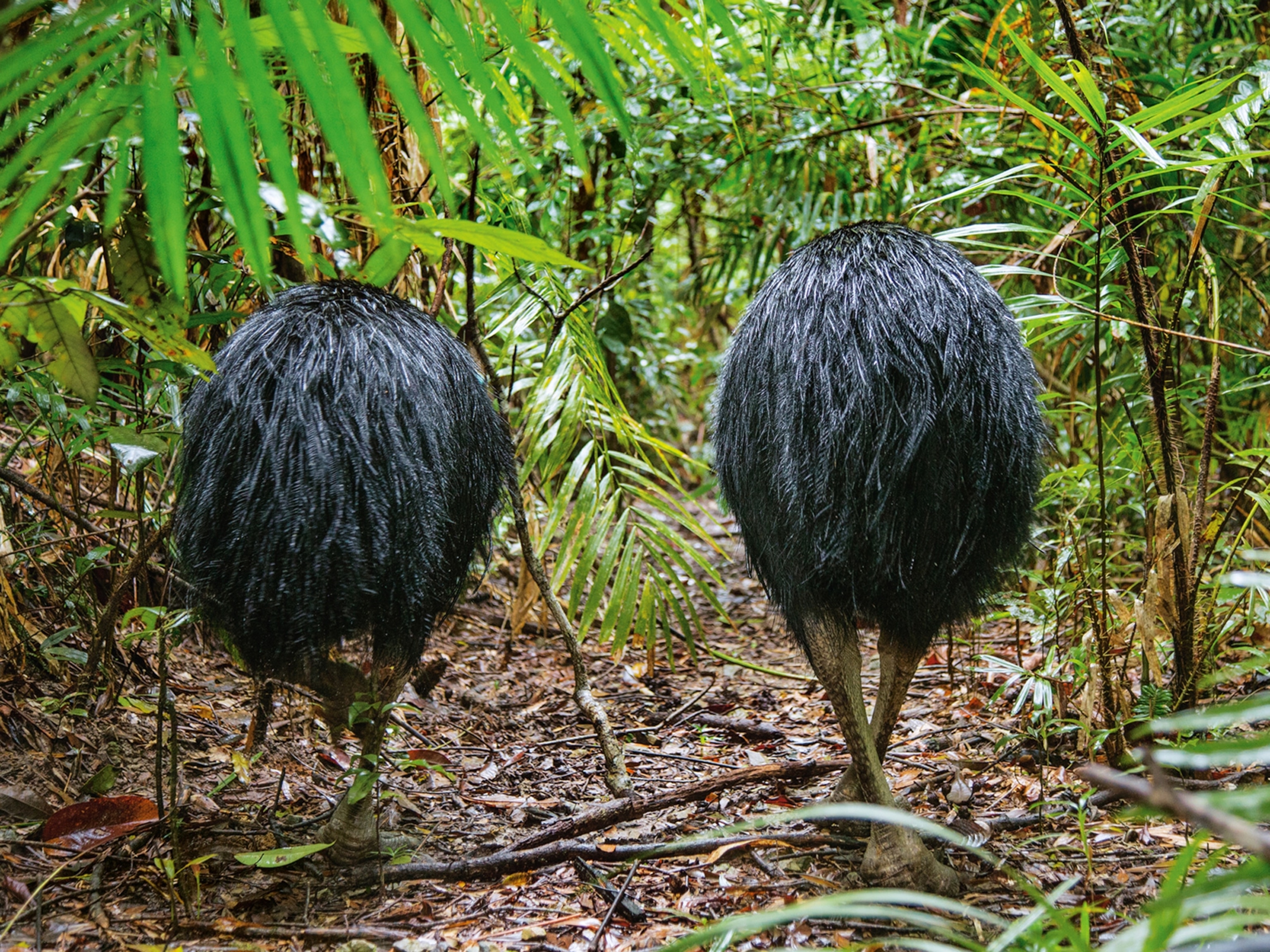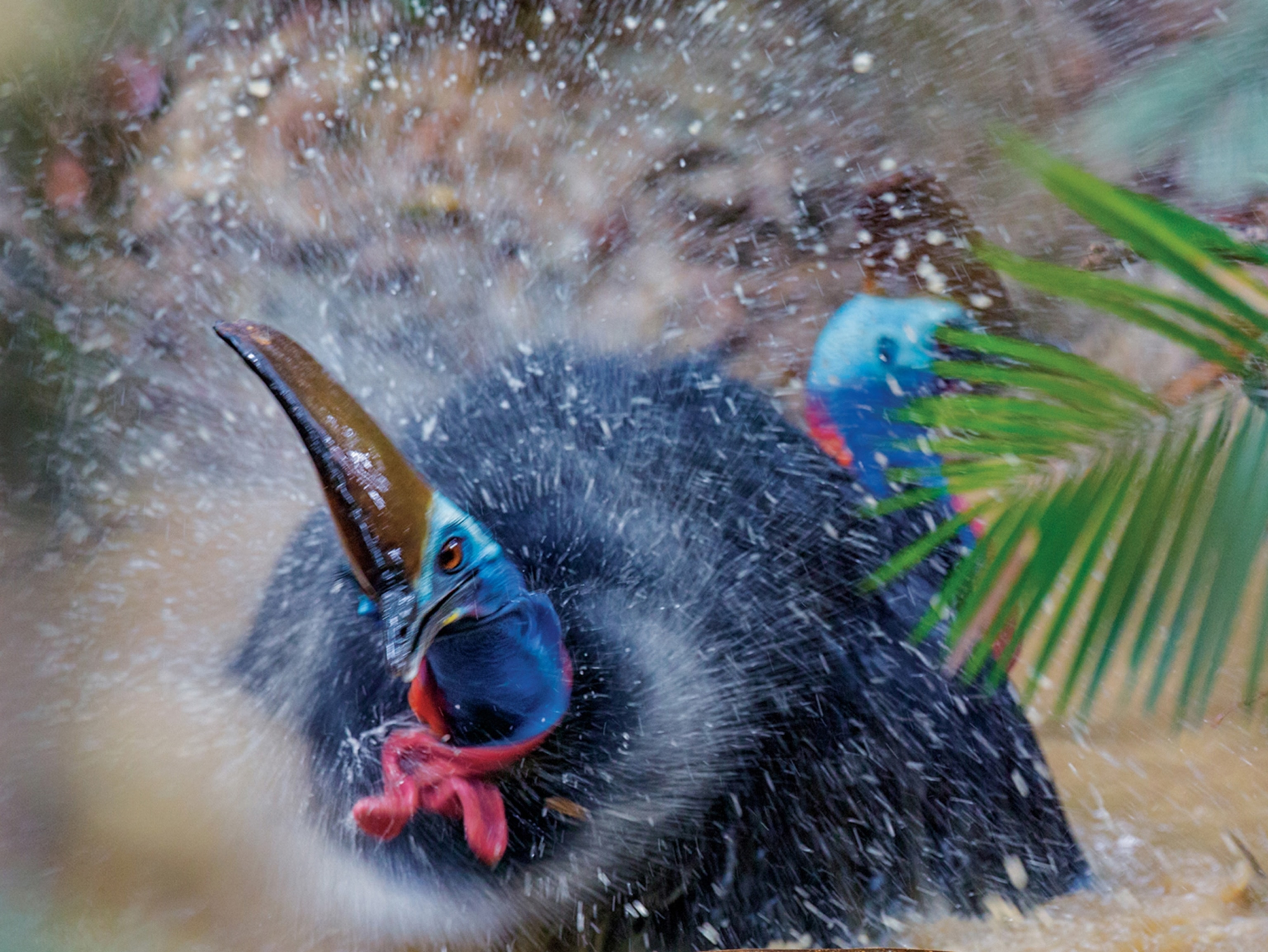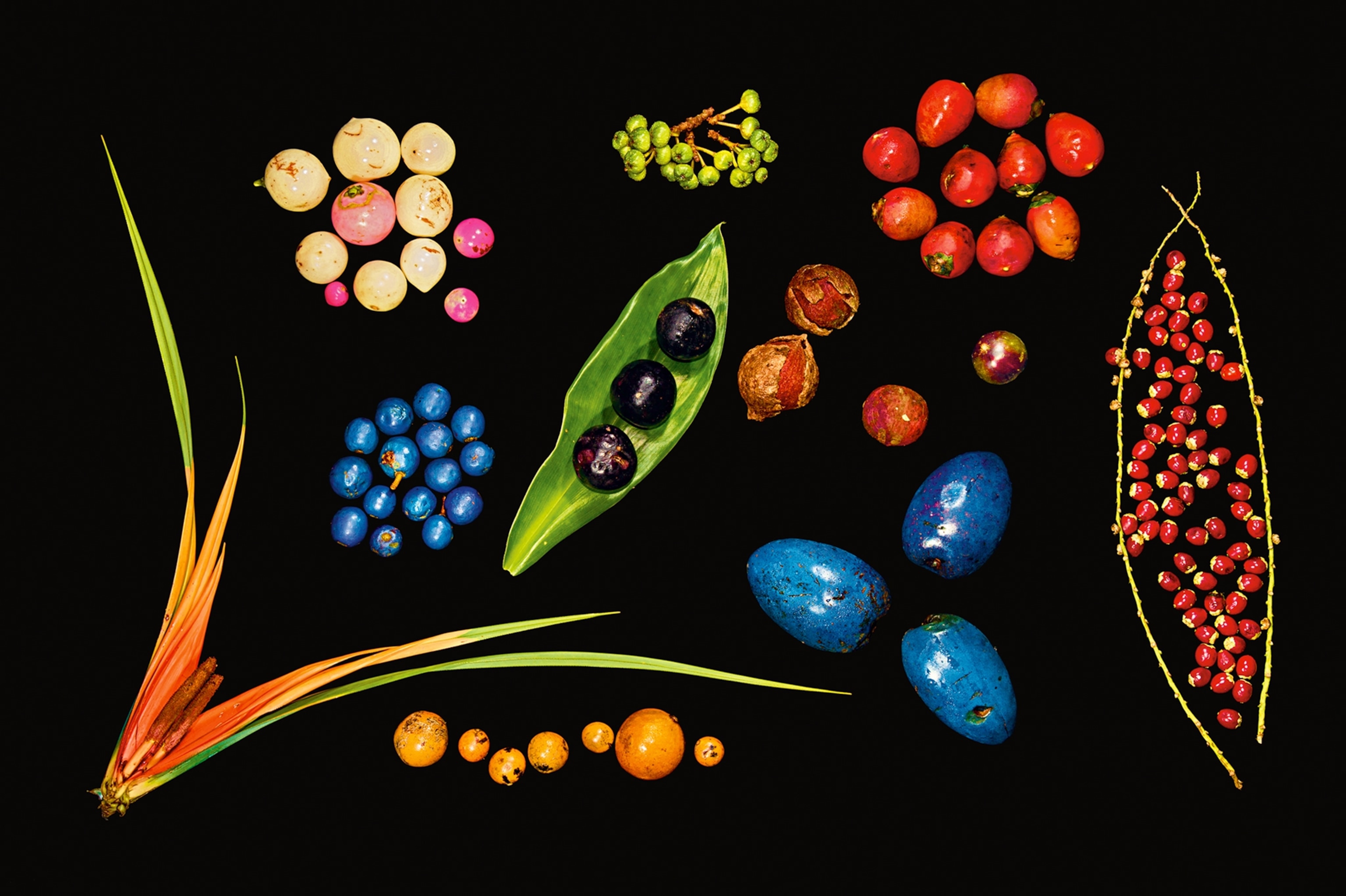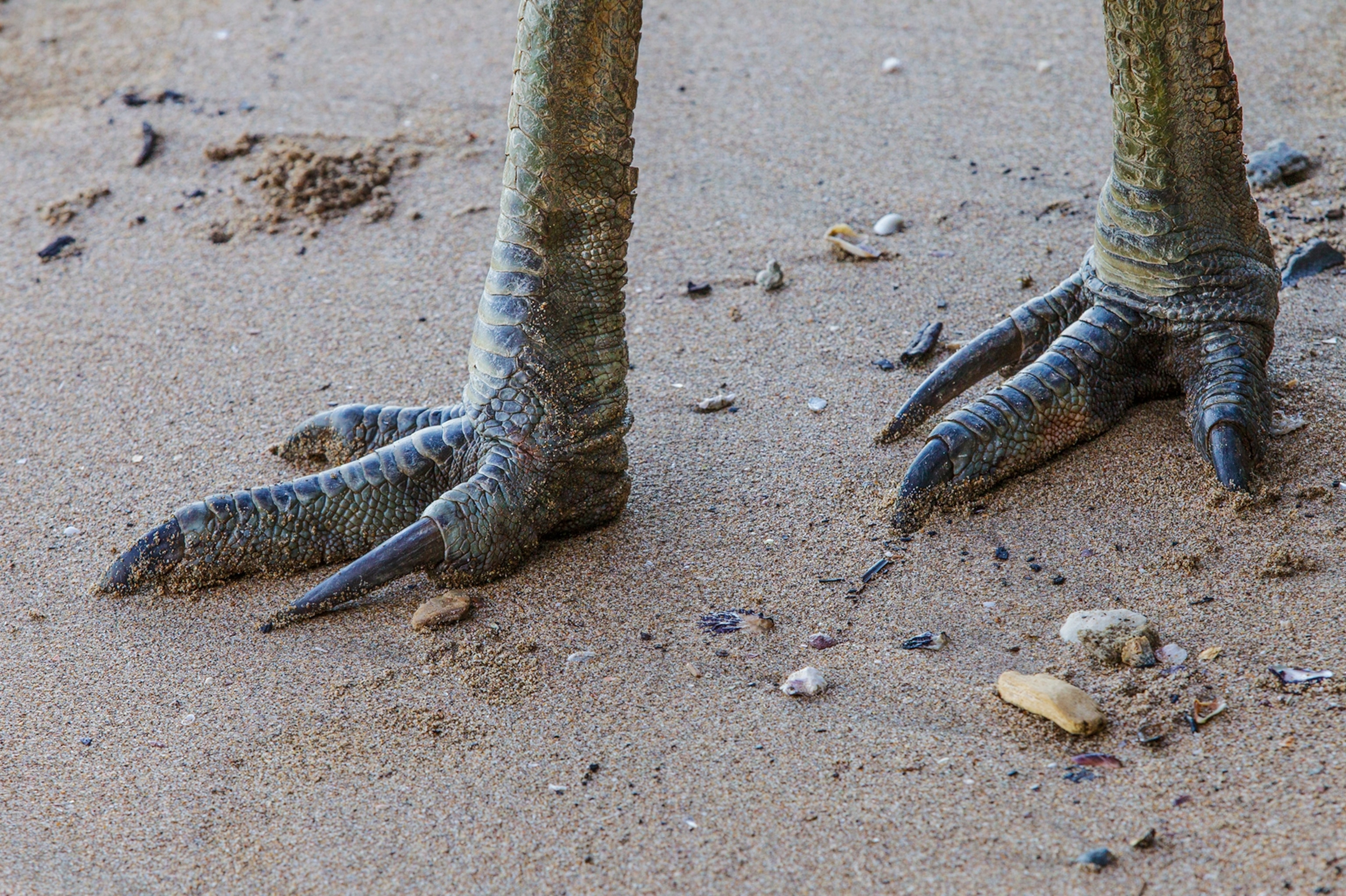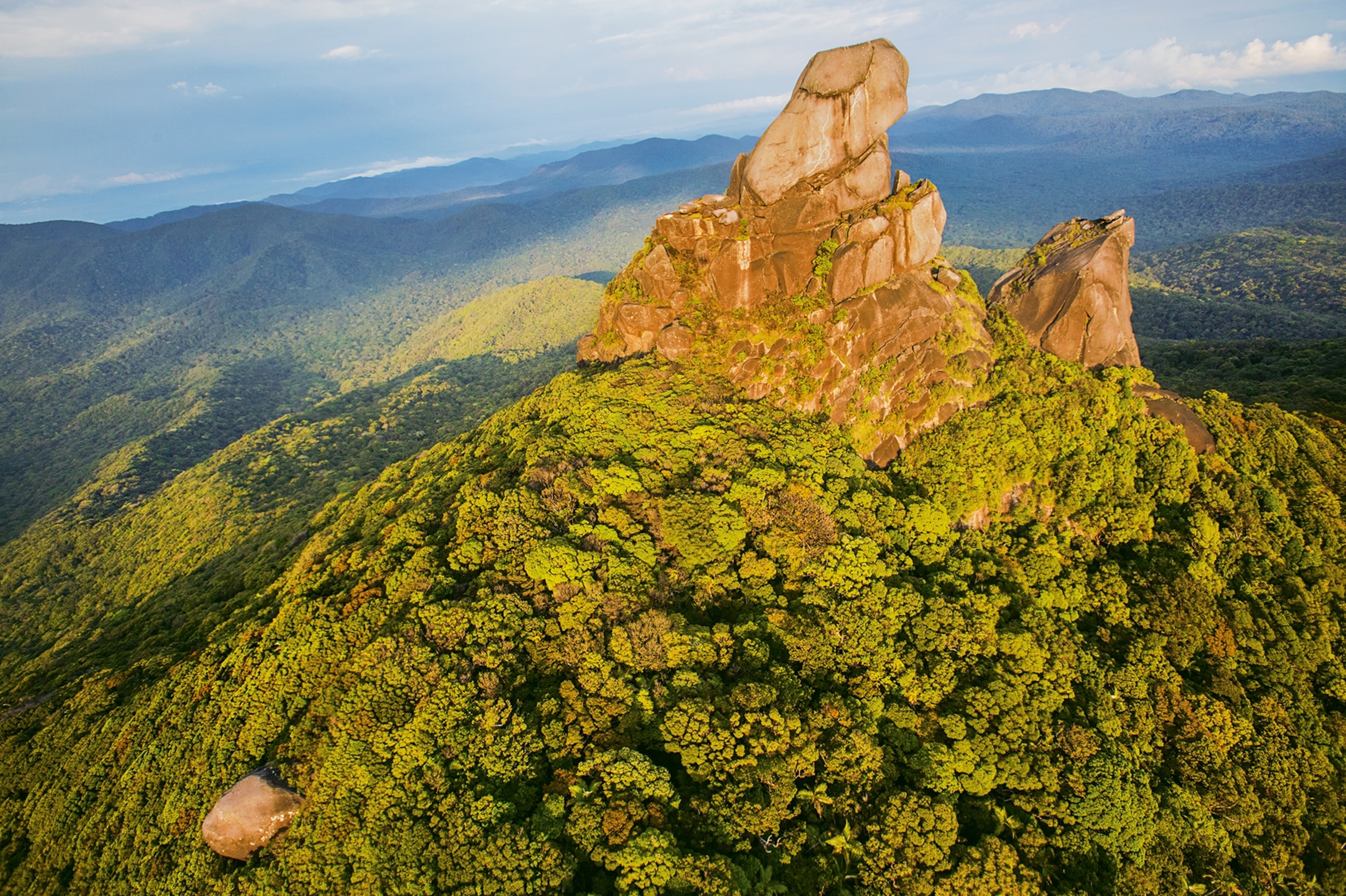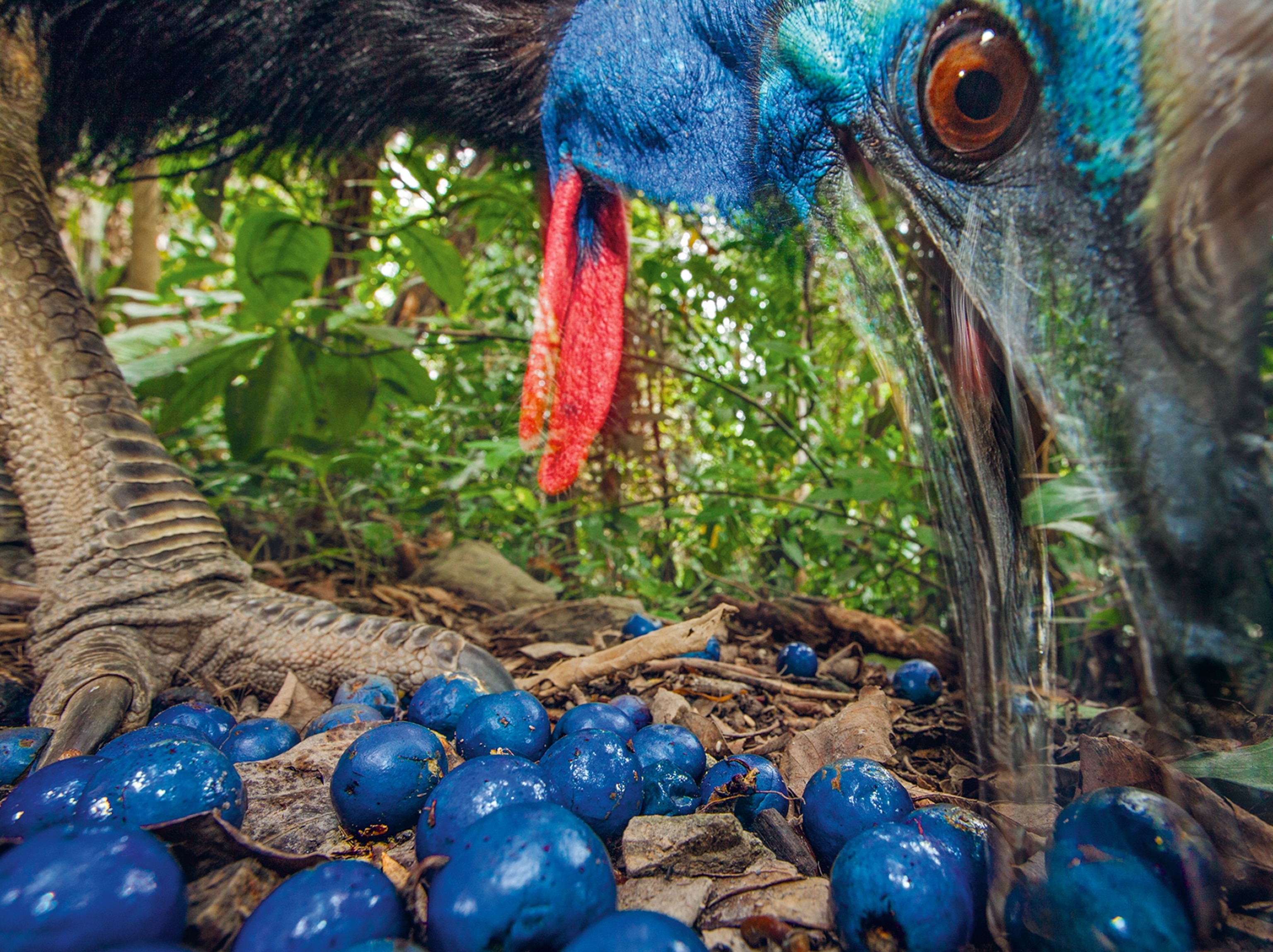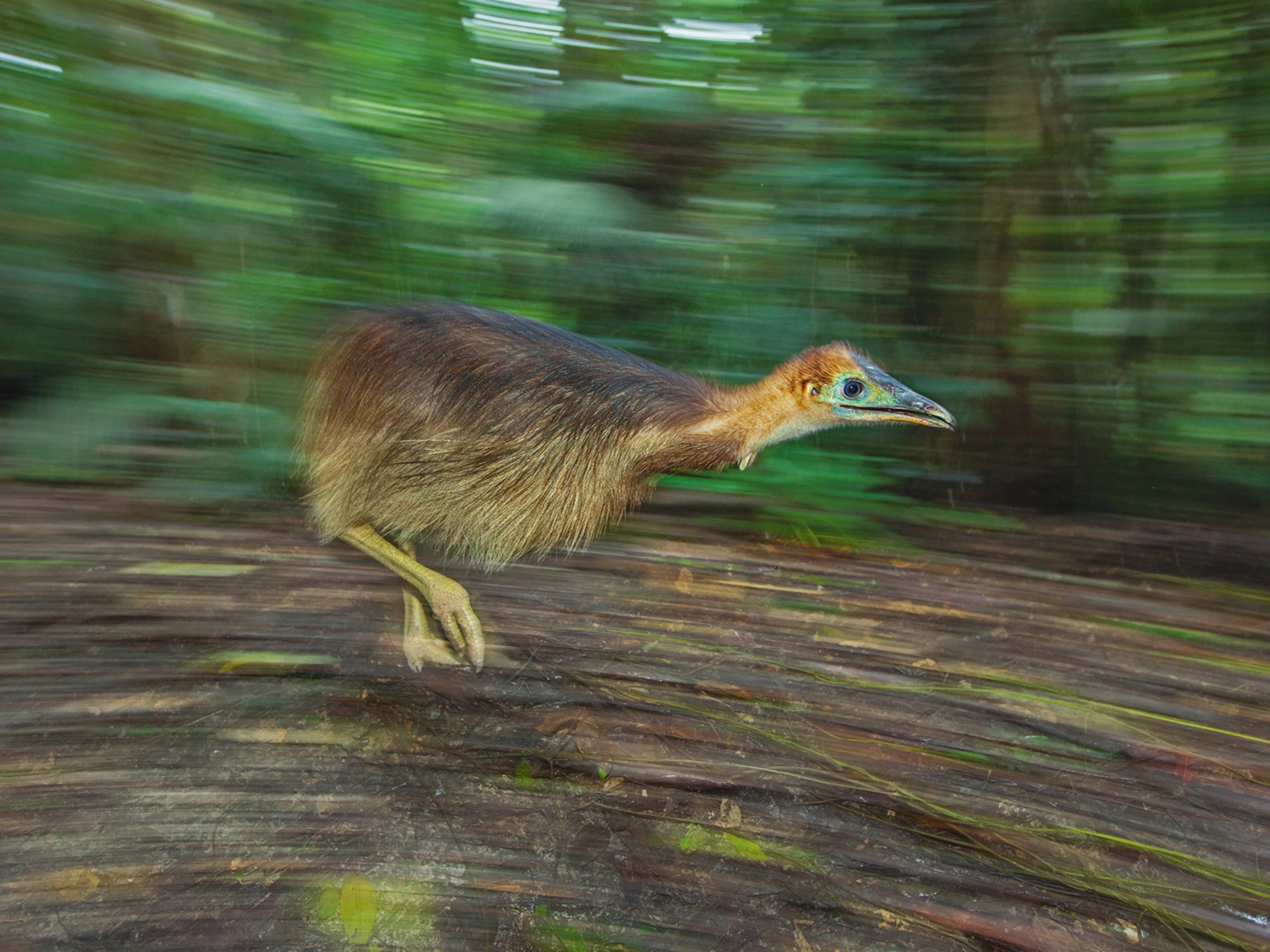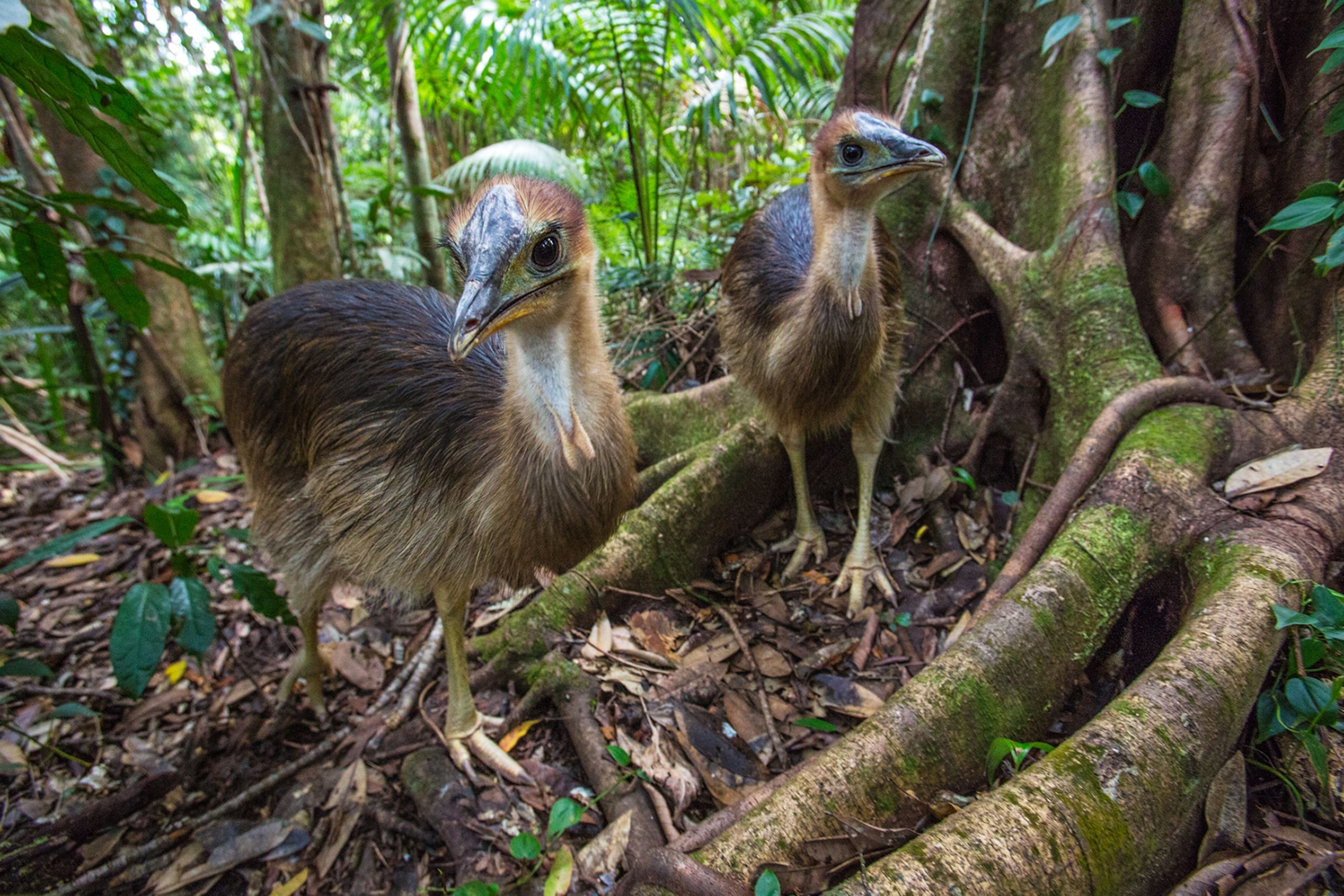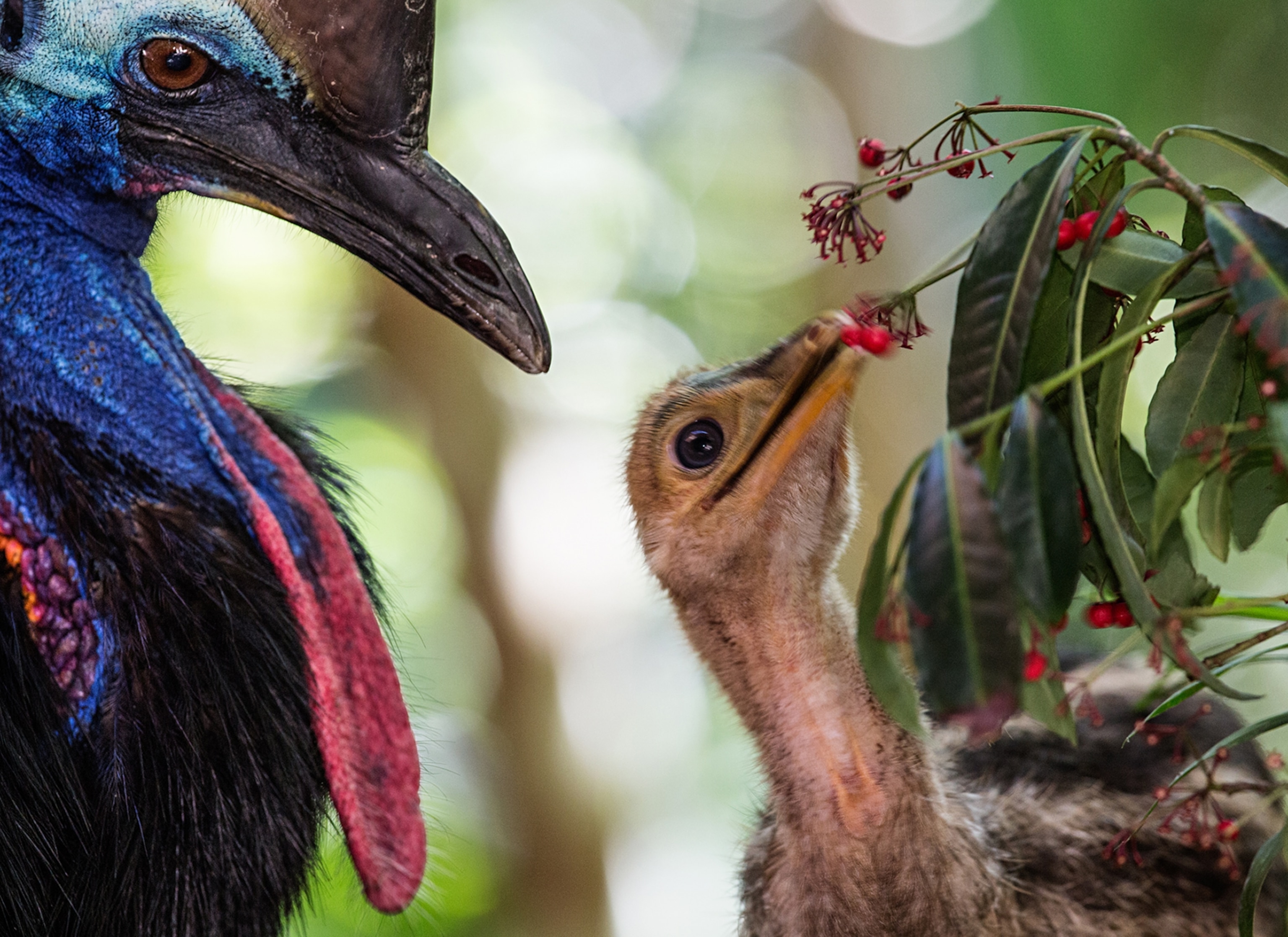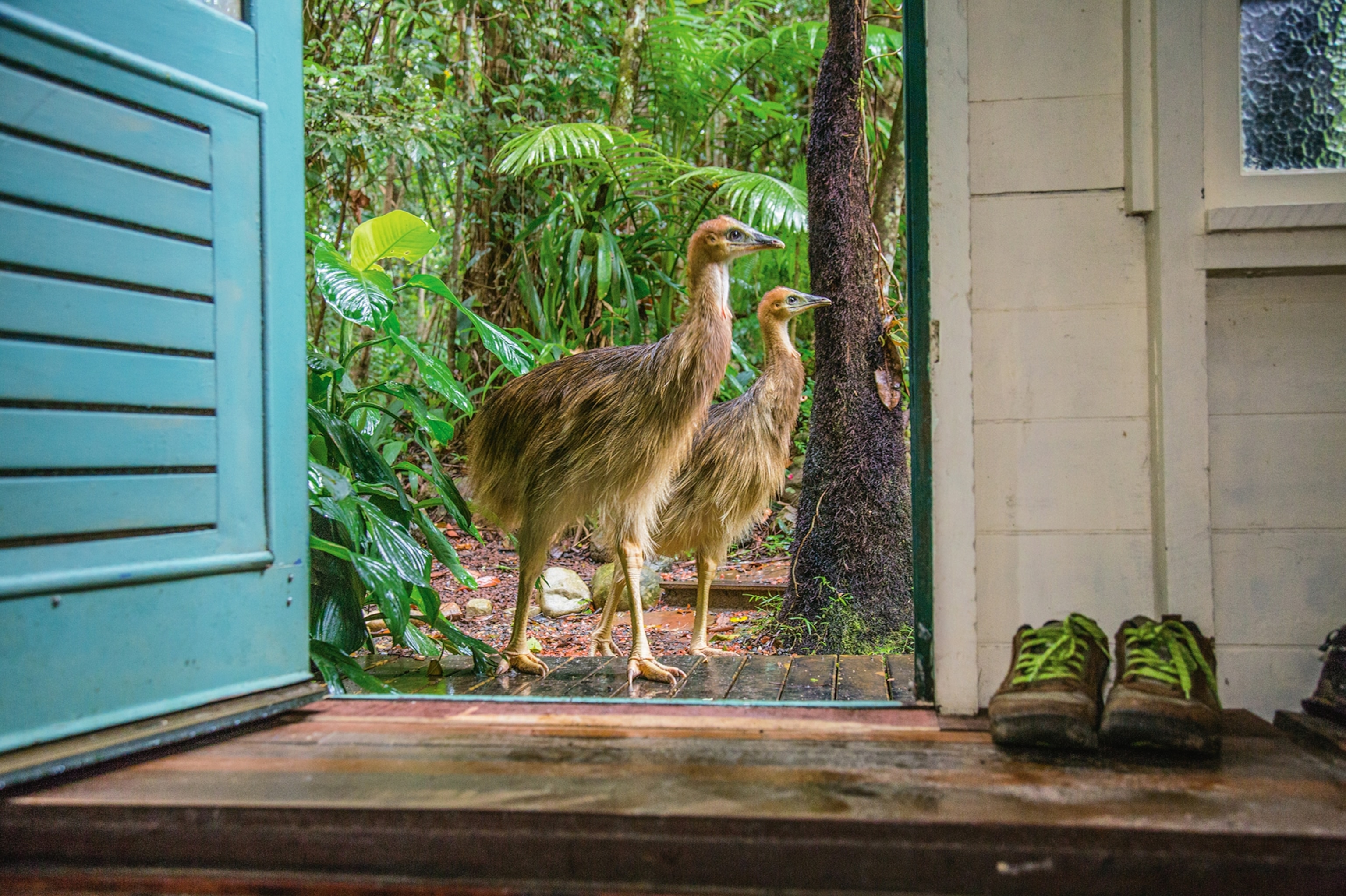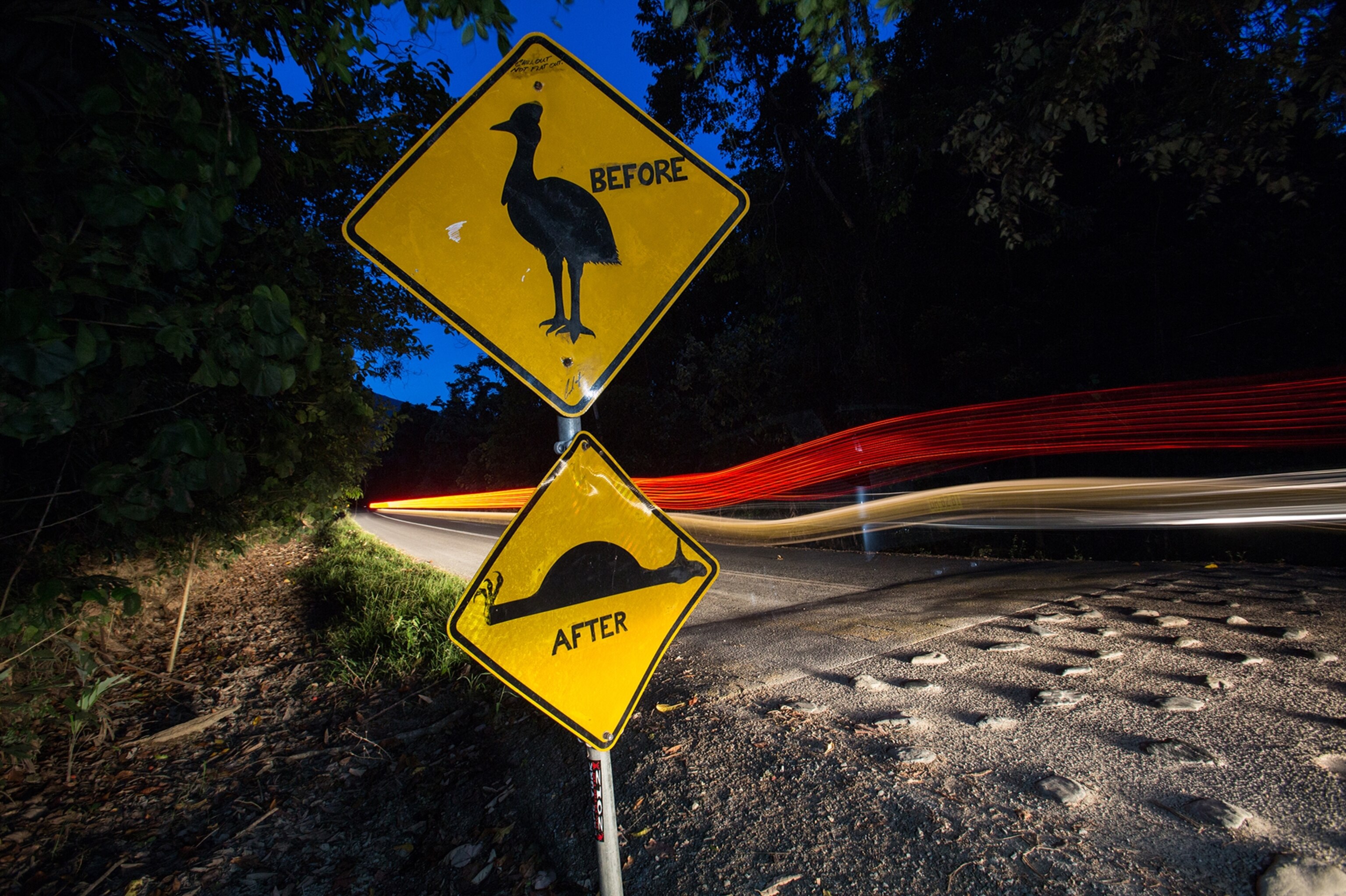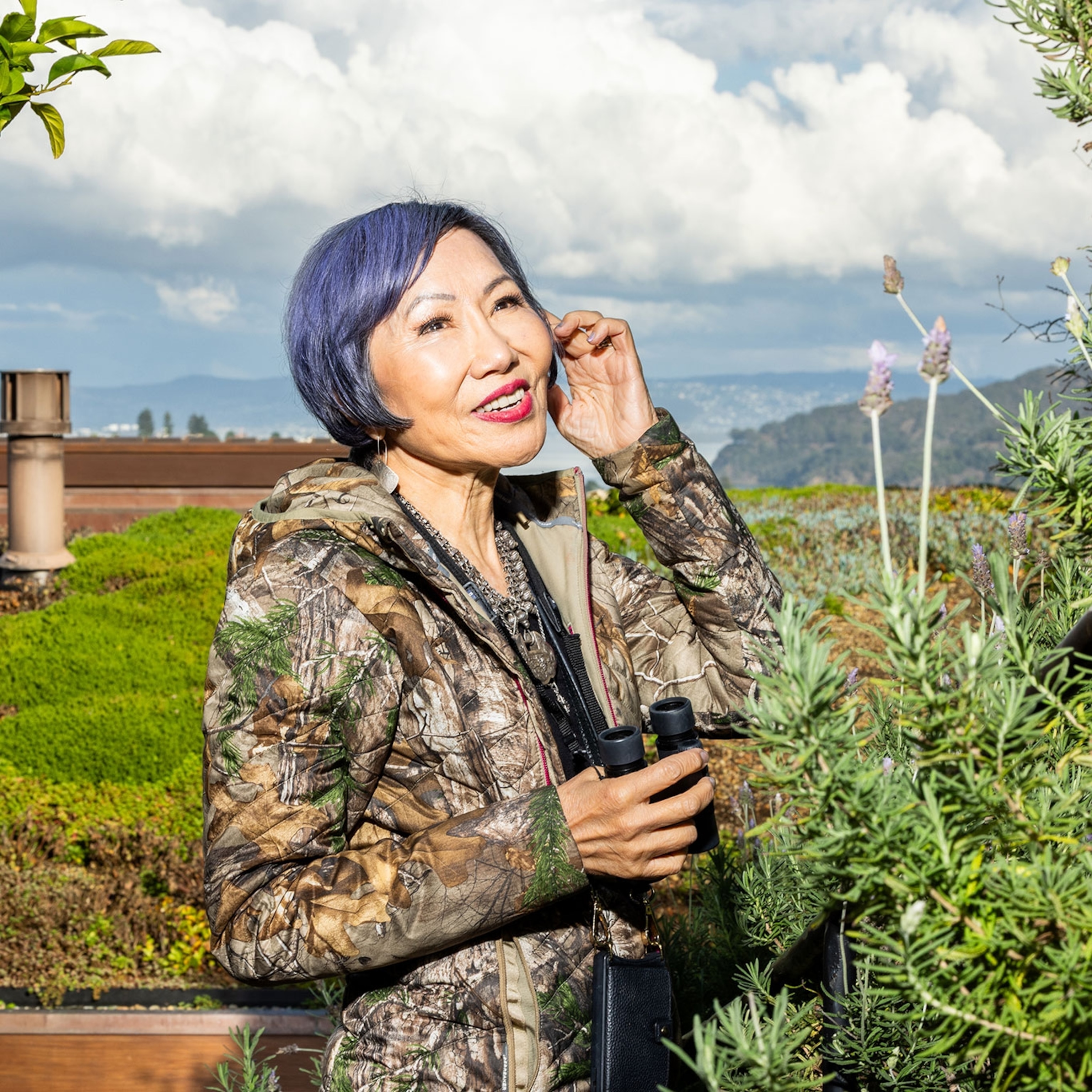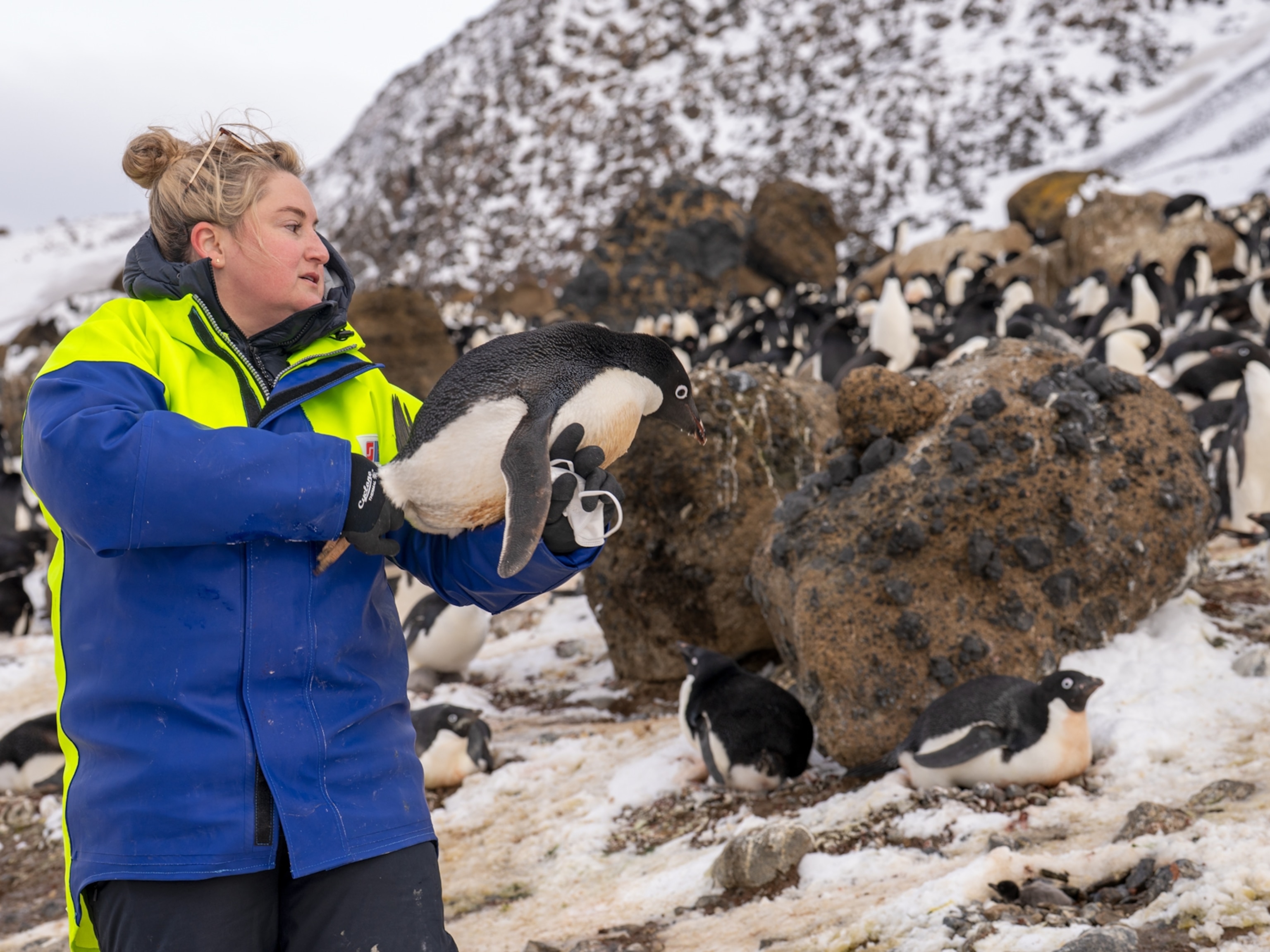Big Bird
In the far north of Australia the cassowary plays a central role in shaping the rain forest.
On the ground in front of me there’s a large round pile of what looks like moist purple mud. It’s roughly the volume of a baseball cap, and it’s studded with berries and seeds—more than 50. Some of the seeds are larger than an avocado stone.
I kneel down to look more closely. Putting my nose just a couple of inches away, I take a sniff. It smells of fruit mixed with a whiff of vinegar. There’s also a hint of that mouth-puckering, astringent flavor you get from strong black tea. Peculiar. But not unpleasant.
What is it? It’s a bird dropping. A big bird dropping. From a big bird.
I stand up and look around. I’m in the Daintree Rainforest, two hours’ drive up the coast from the seaside city of Cairns, in the far north of Australia. Here and there, shafts of sunlight fall through the canopy, dappling the ground. On a tree beside me, I spot a Boyd’s forest dragon—a handsome lizard with a crest on its head and spikes down its spine. Somewhere nearby, insects are singing. But of a big bird—no sign.
Probably I wouldn’t see it even if it was right there, just through those trees. Despite its bigness, it blends in with the shadows of the forest.
The bird in question? Casuarius casuarius, the southern cassowary, fruit-eater-in-chief of Australia’s rain forests.
Cassowaries are large, flightless birds related to emus and (more distantly) to ostriches, rheas, and kiwis. Today there are three species. Two are confined to the rain forests of New Guinea and nearby islands. The third and largest—the southern cassowary—also lives in the Wet Tropics of northern Queensland, in the part of Australia that sticks up at New Guinea like a spike. Some live deep in tracts of rain forest, such as the Daintree; others live on the forest edge and may wander through people’s backyards.
But a cassowary is not your regular garden bird. If an adult male stretches up to his full height, he can look down on someone five feet five—i.e., me—and he may weigh more than 110 pounds. Adult females are even taller, and can weigh more than 160 pounds. Among living birds, only ostriches are more massive. Most of the time, however, cassowaries seem smaller than they are, because they don’t walk in the stretched-up position but slouch along with their backs parallel to the ground.
Their feathers are glossy black; their legs are scaly. Their feet have just three toes—and the inside toe of each foot has evolved into a formidable spike. Their wings are tiny, having shrunk almost to the point of nonexistence. But their necks are long, and bare of all but the lightest coating of short, hairlike feathers. Instead the skin is colored with amazing hues of reds and oranges, purples and blues. At the base of the neck in the front, a couple of long folds of colorful skin, known as wattles, hang down. Cassowaries have large brown eyes and a long, curved beak. On their heads they wear a tall, hornlike casque.
You need only see two or three to know that unlike, say, sparrows, cassowaries can easily be recognized as individuals. This one has splendid long wattles and a straight casque; that one has a casque that curves rakishly to the right. This clear individuality, together with their size and the fact that they do not fly, makes them strangely humanlike: They move like people, they are people-size, and they are easy to tell apart. Because of this, it’s common for people to give them names—such as Crinklecut, Big Bertha, or Dad. It might also explain why they have long figured in the mythologies of rain forest tribes. Some believe that cassowaries are cousins of humans; others, that they are people who have been reincarnated; still others, that humans were created from the feathers of a female. However, unlike in humans, males do all the child care—they sit on the eggs, and look after the chicks for nine months or more—so they also inspire envy. “I’m coming back as a female cassowary!” one mother of five told me.
Adding to their mystique, cassowaries have a reputation for being dangerous. And certainly if you keep them in a pen and rush at them with a rake—which, judging by videos posted on YouTube, some people do—they are. They are big, they have claws and a powerful kick, and they will use them. If cassowaries come to associate humans with food handouts, they can become aggressive and demanding. If you get close to a male with young chicks, he may charge you in an attempt to protect them. If you try to catch or kill a cassowary, it may fight back—and could well get the better of you. They sometimes kill dogs.
But let’s get this straight. Left to themselves and treated with respect, cassowaries are shy, peaceable, and harmless. In Australia the last recorded instance of a cassowary killing a person was in 1926—and that was in self-defense.
Dad has a territory near Kuranda, a small town in the hills behind Cairns; he has lived here for at least 30 years. His territory includes a patch of dense forest, a road, and the garden of Cassowary House, a guesthouse where I’m staying for a few days. Despite the summer heat, the bed has an electric blanket—to keep the sheets dry in the sodden rain forest air. And while I sit on a veranda drinking coffee, Dad and his three chicks stroll about below.
Dad’s casque veers off at an angle and looks a bit mangled. His chicks, which are about four weeks old and almost knee-high, make funny whistling-peeping sounds as they run about. He mostly stays silent—but from time to time clacks his bill, making a loud banging noise. He burps too. And occasionally he booms. That is, he tucks his head down low, inflates his neck, and makes a series of low booming noises. As he does this, his feathers puff up. When he sits down, the chicks cuddle up to him, often snuggling into his feathers.
The chicks have obviously different temperaments. One is adventurous, and wanders far from the family group; sometimes this triggers booming from Dad. Another chick is timid, and keeps close to Dad. This one often seeks its father’s attention. Now and then they touch the tips of their bills together—a cassowary kiss?—but the contact seems to be instigated by the chick, not the father. The chick also picks ticks off its father’s neck and eats them. Yum.
Dad and the chicks seem to follow a loose routine. They eat in the morning, rest during the hot part of the day, and eat again toward dusk. Sometimes they go for a bath in a creek. A bird of prey—a goshawk—has a nest high in a nearby tree, and often the cassowaries stop underneath to see if any food—a dead lizard or perhaps a snake—has been dropped. If it has, they eat it.
But mostly they feast on fruit. In the course of a day a single adult cassowary eats hundreds of fruits and berries. Cassowary digestion is gentle, though, and does not harm the seeds, which emerge intact. And so, as a cassowary wanders through its territory, eating, drinking, bathing, and defecating, it moves seeds from one part of the forest to another—sometimes over distances of half a mile or more. It also moves seeds up hills and across rivers. In short, it transports seeds in ways that gravity alone cannot. By means of their fruit-scented droppings, then, cassowaries are a powerful vehicle for spreading seeds around.
And for a lot of trees, cassowaries are the only vehicle. Australia does have other fruit-eaters—small birds, bats, and marsupials such as the musky rat kangaroo, a furry creature with a pointed face, big ears, and a long, naked tail—but these are too small to carry big fruits very far. And in the rain forest, many trees produce big, heavy fruits with big, heavy seeds, because such seeds grow better in the gloom of the forest floor.
As animals roam around, eating fruit and passing seeds, they create the forest of the future: They give plants new places to grow. Thus, as fruit-eaters-in-chief, cassowaries are also chief architects of the forest.
They help some plants to sprout too. Ryparosa kurrangii, for example, is a tree known only from a small region of Australia’s coastal rain forest. One study showed that without passing through a cassowary, only 4 percent of Ryparosa seeds grow; after passing through a cassowary, 92 percent do. (Why this makes such a difference is not known.)
And so, if the cassowary were to vanish, the structure of the forest would gradually change. Trees of some species would become less widespread, and some species would probably disappear altogether. Which would be a shame. The rain forests of the far north of Australia, such as the Daintree, are relicts from the ancient supercontinent of Gondwana. That is, many of the plants are descendants of those that lived in rain forests that once covered much of Australia and Antarctica, way back, 100 million years ago, when the two continents were sutured together. As such, they are a living museum, a riot of evolutionary pathways, a showcase of different ways to be a plant. There are ferns that look like coconut palms—tall, thin trunks crowned with long, frondlike leaves—and palms with leaves like huge Japanese fans. There are trees on trees, and orchids on trees, and way up high, ferns like baskets.
Unfortunately, however, there’s less of this original forest than there used to be. And as the forest has dwindled, so has the cassowary.
How many are left? This is the most contentious question in cassowary biology. In Australia the bird is listed as endangered; most tallies put the number of cassowaries around 1,500 to 2,000. But these are guesstimates: No one knows for sure.
The trouble is, cassowaries are hard to count. They live alone, in dense forests. Attempts to estimate numbers based on DNA taken from droppings have not been published. Nor have estimates based on photographs of individuals coming to emergency feeding stations set up after cyclones. So it’s not clear if the population is rising or falling—or how close to extinction the birds really are.
What is clear is that cassowaries have problems. Just as cassowaries sometimes kill dogs, dogs sometimes kill cassowaries—especially young birds. Feral pigs may destroy cassowary nests, and cassowaries sometimes die in pig traps. Another hazard is traffic. While I was visiting, one of Dad’s chicks narrowly escaped being hit by a truck. And in Mission Beach, a pretty seaside town south of Cairns, several cassowaries are killed on the roads every year.
I saw one victim, lying in the back of a pickup truck belonging to the Queensland Parks and Wildlife Service; the ranger had collected it right after the accident was called in. It was a young female, just on the edge of sexual maturity. Her casque was small, and she still had a few brown feathers. The bed of the truck was smeared with blood, and muck was oozing out of her mouth. Her legs were scraped. Her eyes were open but unseeing.
I reached over and touched her. The skin on her neck was velvety. And her casque was not hard, as I had expected, but spongy. Seen up close, her feet looked huge.
The ranger was visibly upset, and talked in a steady stream about local cassowary politics, explaining how some groups want to fence off the roads and build underground tunnels for cassowaries to use, while others argue this won’t work, and lobby instead for lower speed limits and more cassowary-crossing signs. “There have been three dead birds in the last six weeks,” he said. He lifted the body out of the truck and put it in a freezer, to await an autopsy. As he did so, another cassowary appeared from behind a building, a jarring contrast between the majesty of the living and the mangled body of the dead.
Roads also carve up the forest. And as the forest becomes more fragmented, it becomes harder for young cassowaries to find their own territories. Because these birds are so territorial, it takes a certain amount of suitable habitat to sustain a population at all. Which brings me to the other big problem: development. In Mission Beach a development called Oasis is typical. It has paved streets with names like Sandpiper Close, lined with streetlamps. But there are no houses yet: just empty lots, the grass neatly mown, garnished with For Sale signs. The only inhabitants are a flock of ibises, sheltering from the sun in the shade of the few remaining trees. And Dad doesn’t know it, but his forest has been put up for sale, which could see it cut down to make way for houses. Some locals are trying to prevent all this—clubbing together to buy land to create nature preserves, replanting rain forest trees on cleared land, and lobbying farmers not to cut down forest. The hope is to link forest fragments, so that young cassowaries looking for territories can move from one fragment to another without having to cross the open fields of sugarcane plantations, or big highways. For the cassowary depends on the forest even more than the forest depends on the cassowary.
I want to leave you with a final image. I’m in the Daintree, the most intact piece of remaining forest. I’m standing by a fig tree, hoping to see Crinklecut—a young male—and his two chicks. Crinklecut’s territory overlaps that of Big Bertha, an enormous and regal female that is probably the chicks’ mother. A human family lives here too, with three children, plus a giant green tree frog that’s moved into the kitchen and lives in a frying pan. Suddenly the youngest of the children comes tearing through the trees to tell me that Crinklecut and his chicks are on their way to a nearby creek. As I come within sight of them, Crinklecut stretches up to his full height and looks at me. Then he and his chicks stroll off, into the dusk.

